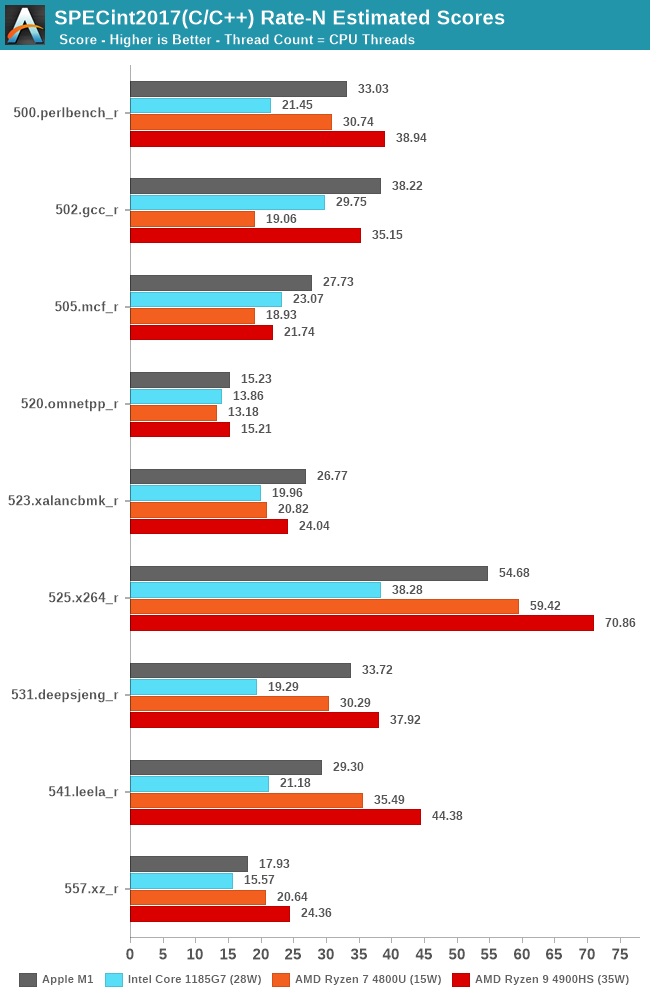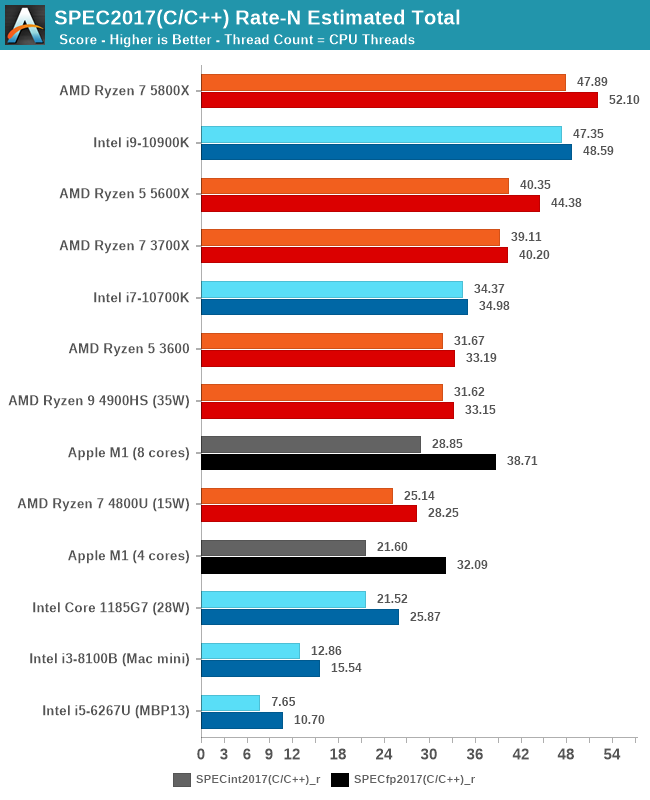The 2020 Mac Mini Unleashed: Putting Apple Silicon M1 To The Test
by Andrei Frumusanu on November 17, 2020 9:00 AM ESTSPEC2017 - Multi-Core Performance
While we knew that the Apple M1 would do extremely well in single-threaded performance, the design’s strengths are also in its power-efficiency which should directly translate to exceptionally good multi-threaded performance in power limited designs. We noted that although Apple doesn’t really publish any TDP figure, we estimate that the M1 here in the Mac mini behaves like a 20-24W TDP chip.
We’re including Intel’s newest Tiger Lake system with an i7-1185G7 at 28W, an AMD Ryzen 7 4800U at 15W, and a Ryzen 9 4900HS at 35W as comparison points. It’s to be noted that the actual power consumption of these devices should exceed that of their advertised TDPs, as it doesn’t account for DRAM or VRMs.

In SPECint2017 rate, the Apple M1 battles with AMD’s chipsets, with the results differing depending on the workload, sometimes winning, sometimes losing.

In the fp2017 rate results, we see similar results, with the Apple M1 battling it out with AMD’s higher-end laptop chip, able to beat the lower TDP part and clearly stay ahead of Intel’s design.

In the overall multi-core scores, the Apple M1 is extremely impressive. On integer workloads, it still seems that AMD’s more recent Renoir-based designs beat the M1 in performance, but only in the integer workloads and at a notably higher TDP and power consumption.
Apple’s lead against Intel’s Tiger Lake SoC at 28W here is indisputable, and shows the reason as to why Apple chose to abandon their long-term silicon partner of 15 years. The M1 not only beats the best Intel has to offer in this market-segment, but does so at less power.
I also included multi-threaded scores of the M1 when ignoring the 4 efficiency cores of the system. Here although it’s an “8-core” design, the heterogeneous nature of the CPUs means that performance is lop-sided towards the big cores. That doesn’t mean that the efficiency cores are absolutely weak: Using them still increases total throughput by 20-33%, depending on the workload, favouring compute-heavy tasks.
Overall, Apple doesn’t just deliver a viable silicon alternative to AMD and Intel, but actually something that’s well outperforms them both in absolute performance as well as power efficiency. Naturally, in higher power-level, higher-core count systems, the M1 can’t keep up to AMD and Intel designs, but that’s something Apple likely will want to address with subsequent designs in that category over the next 2 years.










682 Comments
View All Comments
Kuhar - Wednesday, November 18, 2020 - link
You are wrong. This is literally Apple`s ONLY chip. So I can say it is the highest end chip.TEAMSWITCHER - Wednesday, November 18, 2020 - link
Not for long...Hrunga_Zmuda - Wednesday, November 18, 2020 - link
It's not a chip. It's an SOC. But be that as it may, Apple is literally using multiple chips right now, and they are going to be replacing their whole line right up to the Mac Pro. People think the Mac is small potatoes, but it's the equivalent of a Fortune 500 company. It just looks small because of how massive the iOS ecosystem is. They will easily make money just fine with the whole line updated to the M system. Why? Because Apple doesn't have to sell anything to other companies, so every single thing they make doesn't have to make money by itself. So the Mac Pro's processor might not make a profit itself, but the Mac Pro will.Spunjji - Thursday, November 19, 2020 - link
"Is" is not the same as "will be"Reading comprehension in the comments is not strong.
Spunjji - Tuesday, November 17, 2020 - link
Oh dear. Please don't blame the graphs - or, indeed, the author - when they show you something you didn't want to see.What you see here is extremely competitive performance, that AMD may well exceed when they get to 5nm - but they're not there just yet. For the end-user, what counts is what you can get.
AMD need to get their chips into more designs and with any luck they will; Intel can't bribe away a performance advantage like Zen 3 has forever.
markiz - Thursday, November 19, 2020 - link
For the end-user is not really relevant for this particular discussion, I think?I think the discussion is "philosophical" in nature, as in are there intrinsic differences and advantages of one over the other?
E.g., can AMD (or Intel, or Qualcomm) in lets say 2 years offer a SOC as efficeint and as performant as apple can?
So as to say, is it a matter of time, is that time reasonable, or is it unsurmountable?
If I knew Qualcomm will offer a comparable snapdragon in 2022 (and MS sorts the emulation issues), or if AMD will offer comparable chip in 2022, i am good, and would pick from a wastly wider pool of hw designs of windows ecosystem. I like convertibles.
If on the other hand this time frame is larger, or if they will never offer either the efficiency or performance, I would switch to apple all be damned.
BushLin - Thursday, November 19, 2020 - link
..."can AMD (or Intel, or Qualcomm) in lets say 2 years offer a SOC as efficeint and as performant as apple can?"AMD have a comparable chip available now in performance and power, been out for ages and it's in the benchmarks. If you need your system to do some actual work, the 4800U is a better chip. If your workload doesn't scale to many threads and the software is available for the new ARM platform then Apple's silicon looks pretty sweet.
haghands - Tuesday, November 17, 2020 - link
Copeadt6247 - Tuesday, November 17, 2020 - link
The parts that beat the M1 have way more cores, a higher thermal budget, and higher clock.There's a lot of things to optimize for, and in its current form, Apple silicon doesn't offer solutions to all desktop workflows -- number of PCIe lanes comes to mind as a limitation.
AMD isn't wholly beaten, but they're also not playing the same game. The best thing to come out of this would be lighting a fire under AMD's butt.
But AMD will be chasing higher IPC and performance per watt, while Apple will be chasing higher core counts, higher thermal and power budget for desktop parts, and higher clocks. I'm hoping Intel is going to rebound with competitive parts in a couple years. Competition makes everyone better!
BushLin - Tuesday, November 17, 2020 - link
Er... Similar power drawn by old zen 2 design at 7nm which is giving better multithreaded performance.